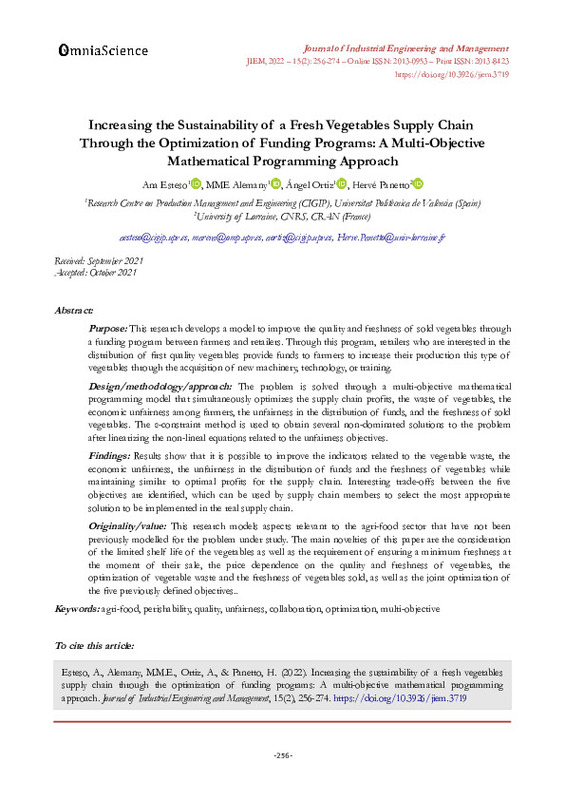JavaScript is disabled for your browser. Some features of this site may not work without it.
Buscar en RiuNet
Listar
Mi cuenta
Estadísticas
Ayuda RiuNet
Admin. UPV
Increasing the Sustainability of a Fresh Vegetables Supply Chain Through the Optimization of Funding Programs: A Multi-Objective Mathematical Programming Approach
Mostrar el registro sencillo del ítem
Ficheros en el ítem
| dc.contributor.author | Esteso, Ana
|
es_ES |
| dc.contributor.author | Alemany Díaz, María Del Mar
|
es_ES |
| dc.contributor.author | Ortiz Bas, Ángel
|
es_ES |
| dc.contributor.author | Panetto, Hervé
|
es_ES |
| dc.date.accessioned | 2022-10-06T18:05:35Z | |
| dc.date.available | 2022-10-06T18:05:35Z | |
| dc.date.issued | 2022 | es_ES |
| dc.identifier.issn | 2013-0953 | es_ES |
| dc.identifier.uri | http://hdl.handle.net/10251/187189 | |
| dc.description.abstract | [EN] Purpose: This research develops a model to improve the quality and freshness of sold vegetables through a funding program between farmers and retailers. Through this program, retailers who are interested in the distribution of first quality vegetables provide funds to farmers to increase their production this type of vegetables through the acquisition of new machinery, technology, or training. Design/methodology/approach: The problem is solved through a multi-objective mathematical programming model that simultaneously optimizes the supply chain profits, the waste of vegetables, the economic unfairness among farmers, the unfairness in the distribution of funds, and the freshness of sold vegetables. The ¿-constraint method is used to obtain several non-dominated solutions to the problem after linearizing the non-lineal equations related to the unfairness objectives. Findings: Results show that it is possible to improve the indicators related to the vegetable waste, the economic unfairness, the unfairness in the distribution of funds and the freshness of vegetables while maintaining similar to optimal profits for the supply chain. Interesting trade-offs between the five objectives are identified, which can be used by supply chain members to select the most appropriate solution to be implemented in the real supply chain. Originality/value: This research models aspects relevant to the agri-food sector that have not been previously modelled for the problem under study. The main novelties of this paper are the consideration of the limited shelf life of the vegetables as well as the requirement of ensuring a minimum freshness at the moment of their sale, the price dependence on the quality and freshness of vegetables, the optimization of vegetable waste and the freshness of vegetables sold, as well as the joint optimization of the five previously defined objectives. | es_ES |
| dc.description.sponsorship | The authors acknowledge the support of the Project 691249, "RUCAPS: Enhancing and implementing Knowledge based ICT solutions within high Risk and Uncertain Conditions for Agriculture Production Systems", funded by the EU under its funding scheme H2020-MCSA-RISE-2015. | es_ES |
| dc.language | Inglés | es_ES |
| dc.publisher | Omnia Publisher SL | es_ES |
| dc.relation.ispartof | Journal of Industrial Engineering and Management | es_ES |
| dc.rights | Reconocimiento - No comercial (by-nc) | es_ES |
| dc.subject | Agri-food | es_ES |
| dc.subject | Perishability | es_ES |
| dc.subject | Quality | es_ES |
| dc.subject | Unfairness | es_ES |
| dc.subject | Collaboration | es_ES |
| dc.subject | Optimization | es_ES |
| dc.subject | Multi-objective | es_ES |
| dc.subject.classification | ORGANIZACION DE EMPRESAS | es_ES |
| dc.title | Increasing the Sustainability of a Fresh Vegetables Supply Chain Through the Optimization of Funding Programs: A Multi-Objective Mathematical Programming Approach | es_ES |
| dc.type | Artículo | es_ES |
| dc.identifier.doi | 10.3926/jiem.3719 | es_ES |
| dc.relation.projectID | info:eu-repo/grantAgreement/EC/H2020/691249/EU | es_ES |
| dc.rights.accessRights | Abierto | es_ES |
| dc.contributor.affiliation | Universitat Politècnica de València. Departamento de Organización de Empresas - Departament d'Organització d'Empreses | es_ES |
| dc.description.bibliographicCitation | Esteso, A.; Alemany Díaz, MDM.; Ortiz Bas, Á.; Panetto, H. (2022). Increasing the Sustainability of a Fresh Vegetables Supply Chain Through the Optimization of Funding Programs: A Multi-Objective Mathematical Programming Approach. Journal of Industrial Engineering and Management. 15(2):256-274. https://doi.org/10.3926/jiem.3719 | es_ES |
| dc.description.accrualMethod | S | es_ES |
| dc.relation.publisherversion | https://doi.org/10.3926/jiem.3719 | es_ES |
| dc.description.upvformatpinicio | 256 | es_ES |
| dc.description.upvformatpfin | 274 | es_ES |
| dc.type.version | info:eu-repo/semantics/publishedVersion | es_ES |
| dc.description.volume | 15 | es_ES |
| dc.description.issue | 2 | es_ES |
| dc.relation.pasarela | S\458188 | es_ES |
| dc.contributor.funder | COMISION DE LAS COMUNIDADES EUROPEA | es_ES |
| upv.costeAPC | 598,95 | es_ES |








